Impact of Financial Markets on the Global Business Environment Report
VerifiedAdded on 2023/01/09
|10
|2243
|72
Report
AI Summary
This report examines the significant role financial markets play in the global economy, particularly during the first decade of the 21st century. It analyzes the impact of financial markets on economic activity, highlighting the evolution of financial products and their influence on the 2008 financial crisis. The report explores the benefits of market-based financing and the emergence of new financial instruments, such as those in the Euro area. Furthermore, it discusses how the banking sector's innovations contributed to increased systematic risk. The report concludes with recommendations for mitigating the likelihood of future banking crises, emphasizing the importance of dynamic capital views, regulatory adjustments, and financial stability measures.
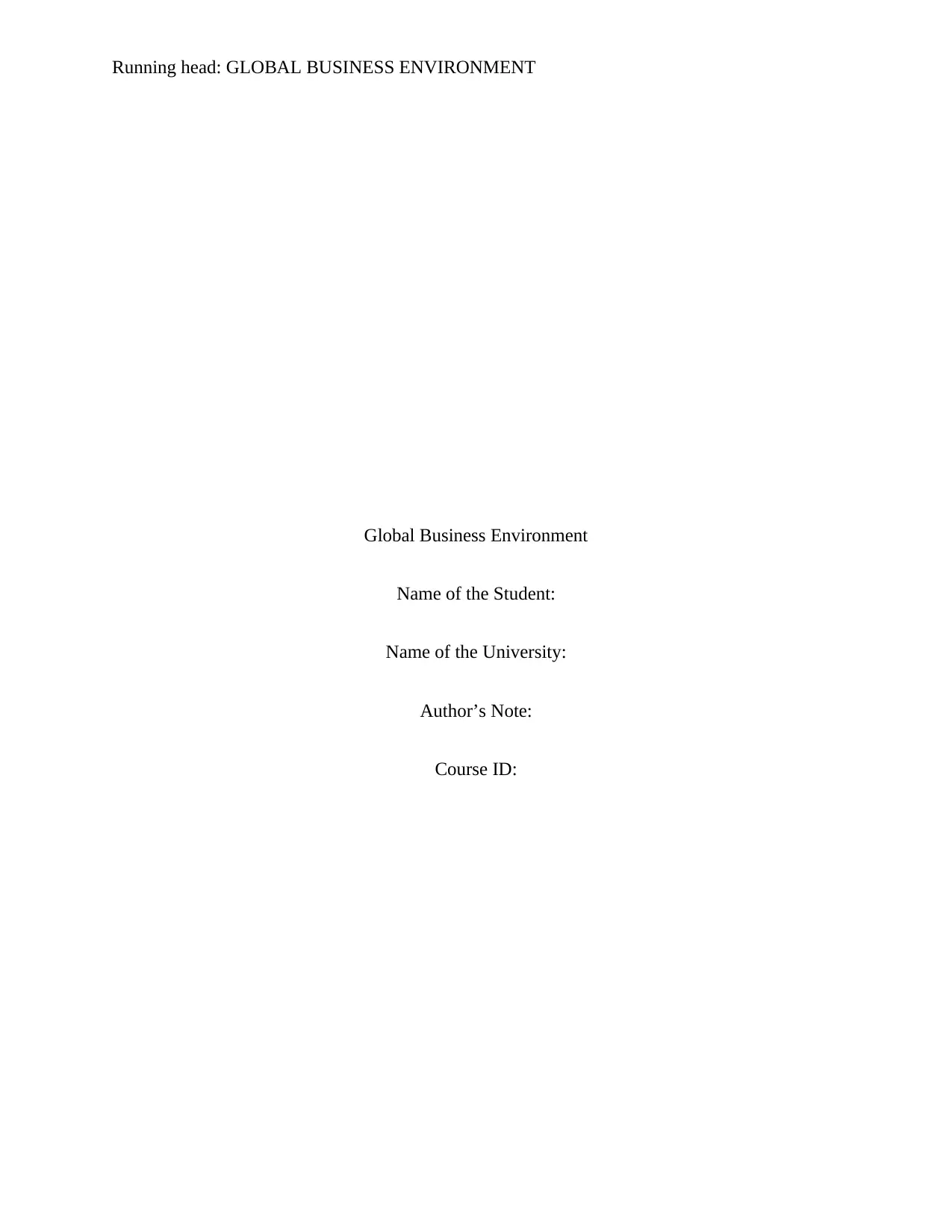
Running head: GLOBAL BUSINESS ENVIRONMENT
Global Business Environment
Name of the Student:
Name of the University:
Author’s Note:
Course ID:
Global Business Environment
Name of the Student:
Name of the University:
Author’s Note:
Course ID:
Paraphrase This Document
Need a fresh take? Get an instant paraphrase of this document with our AI Paraphraser
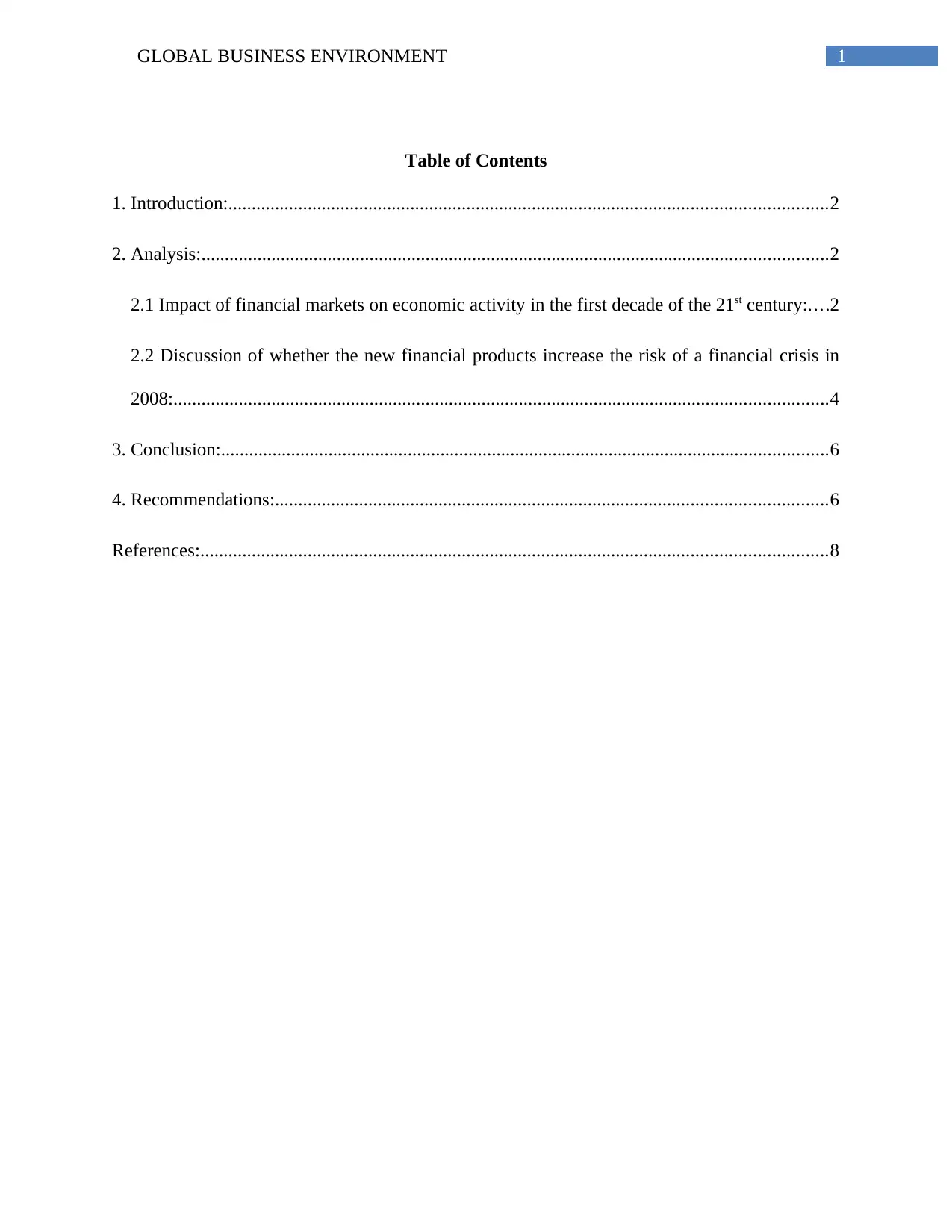
1GLOBAL BUSINESS ENVIRONMENT
Table of Contents
1. Introduction:................................................................................................................................2
2. Analysis:......................................................................................................................................2
2.1 Impact of financial markets on economic activity in the first decade of the 21st century:....2
2.2 Discussion of whether the new financial products increase the risk of a financial crisis in
2008:............................................................................................................................................4
3. Conclusion:..................................................................................................................................6
4. Recommendations:......................................................................................................................6
References:......................................................................................................................................8
Table of Contents
1. Introduction:................................................................................................................................2
2. Analysis:......................................................................................................................................2
2.1 Impact of financial markets on economic activity in the first decade of the 21st century:....2
2.2 Discussion of whether the new financial products increase the risk of a financial crisis in
2008:............................................................................................................................................4
3. Conclusion:..................................................................................................................................6
4. Recommendations:......................................................................................................................6
References:......................................................................................................................................8
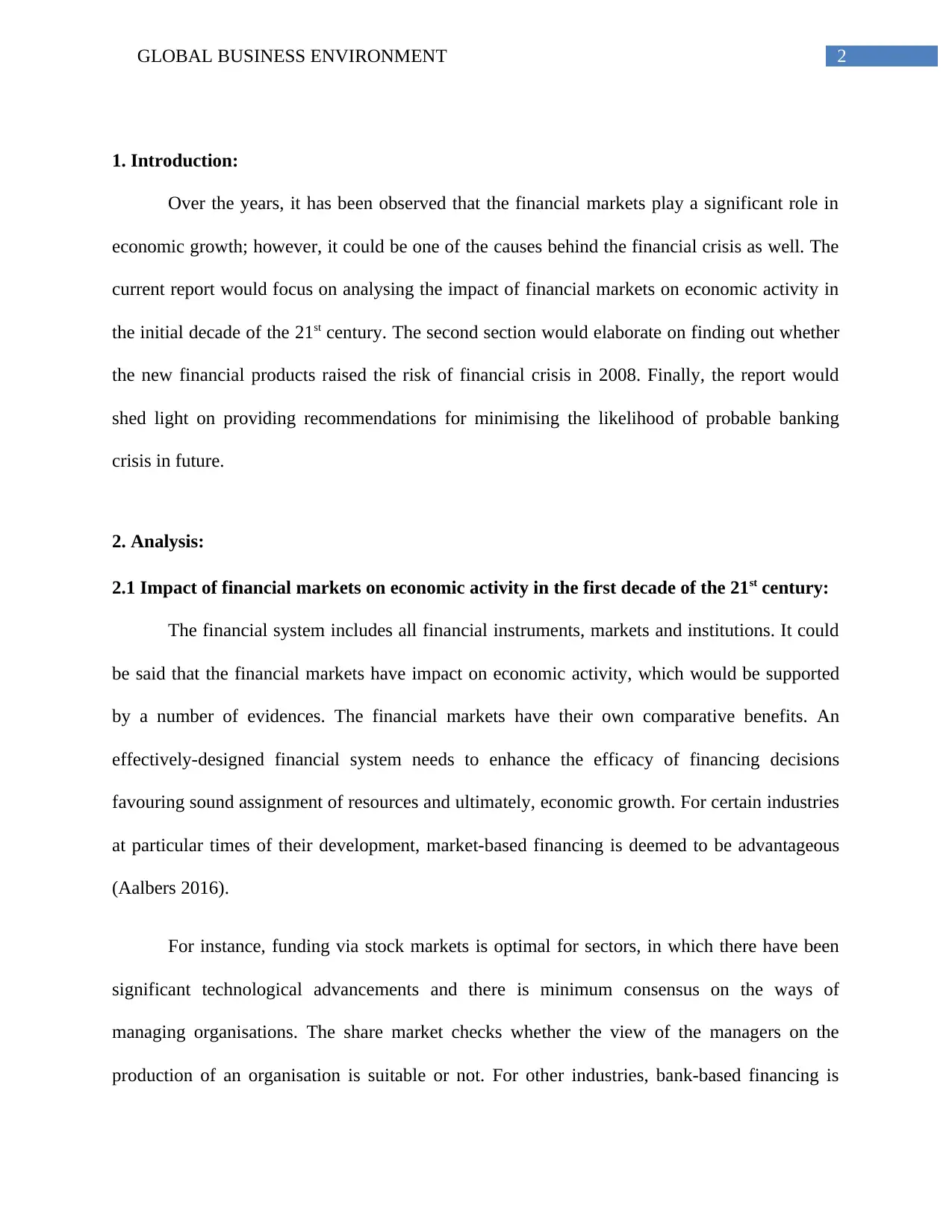
2GLOBAL BUSINESS ENVIRONMENT
1. Introduction:
Over the years, it has been observed that the financial markets play a significant role in
economic growth; however, it could be one of the causes behind the financial crisis as well. The
current report would focus on analysing the impact of financial markets on economic activity in
the initial decade of the 21st century. The second section would elaborate on finding out whether
the new financial products raised the risk of financial crisis in 2008. Finally, the report would
shed light on providing recommendations for minimising the likelihood of probable banking
crisis in future.
2. Analysis:
2.1 Impact of financial markets on economic activity in the first decade of the 21st century:
The financial system includes all financial instruments, markets and institutions. It could
be said that the financial markets have impact on economic activity, which would be supported
by a number of evidences. The financial markets have their own comparative benefits. An
effectively-designed financial system needs to enhance the efficacy of financing decisions
favouring sound assignment of resources and ultimately, economic growth. For certain industries
at particular times of their development, market-based financing is deemed to be advantageous
(Aalbers 2016).
For instance, funding via stock markets is optimal for sectors, in which there have been
significant technological advancements and there is minimum consensus on the ways of
managing organisations. The share market checks whether the view of the managers on the
production of an organisation is suitable or not. For other industries, bank-based financing is
1. Introduction:
Over the years, it has been observed that the financial markets play a significant role in
economic growth; however, it could be one of the causes behind the financial crisis as well. The
current report would focus on analysing the impact of financial markets on economic activity in
the initial decade of the 21st century. The second section would elaborate on finding out whether
the new financial products raised the risk of financial crisis in 2008. Finally, the report would
shed light on providing recommendations for minimising the likelihood of probable banking
crisis in future.
2. Analysis:
2.1 Impact of financial markets on economic activity in the first decade of the 21st century:
The financial system includes all financial instruments, markets and institutions. It could
be said that the financial markets have impact on economic activity, which would be supported
by a number of evidences. The financial markets have their own comparative benefits. An
effectively-designed financial system needs to enhance the efficacy of financing decisions
favouring sound assignment of resources and ultimately, economic growth. For certain industries
at particular times of their development, market-based financing is deemed to be advantageous
(Aalbers 2016).
For instance, funding via stock markets is optimal for sectors, in which there have been
significant technological advancements and there is minimum consensus on the ways of
managing organisations. The share market checks whether the view of the managers on the
production of an organisation is suitable or not. For other industries, bank-based financing is
⊘ This is a preview!⊘
Do you want full access?
Subscribe today to unlock all pages.

Trusted by 1+ million students worldwide
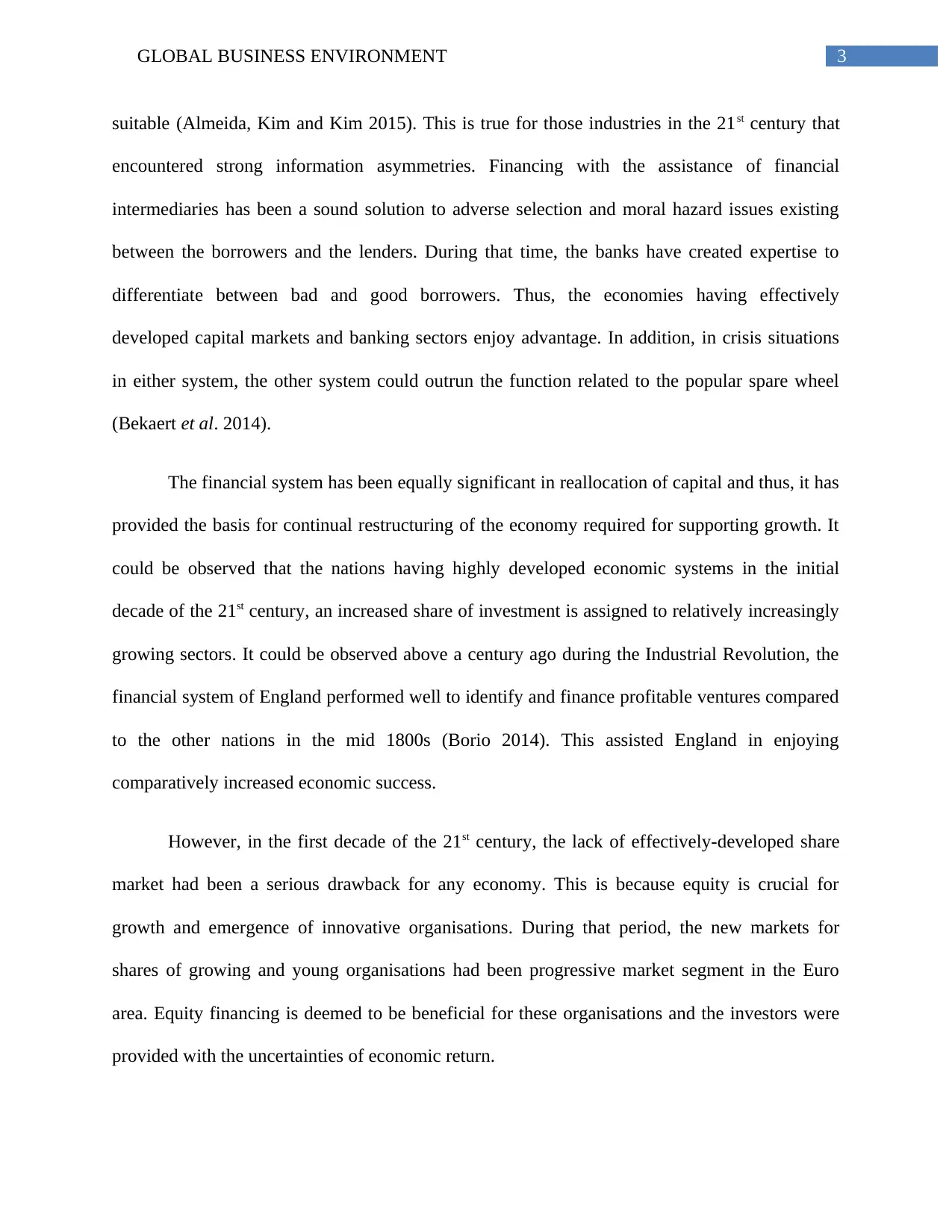
3GLOBAL BUSINESS ENVIRONMENT
suitable (Almeida, Kim and Kim 2015). This is true for those industries in the 21st century that
encountered strong information asymmetries. Financing with the assistance of financial
intermediaries has been a sound solution to adverse selection and moral hazard issues existing
between the borrowers and the lenders. During that time, the banks have created expertise to
differentiate between bad and good borrowers. Thus, the economies having effectively
developed capital markets and banking sectors enjoy advantage. In addition, in crisis situations
in either system, the other system could outrun the function related to the popular spare wheel
(Bekaert et al. 2014).
The financial system has been equally significant in reallocation of capital and thus, it has
provided the basis for continual restructuring of the economy required for supporting growth. It
could be observed that the nations having highly developed economic systems in the initial
decade of the 21st century, an increased share of investment is assigned to relatively increasingly
growing sectors. It could be observed above a century ago during the Industrial Revolution, the
financial system of England performed well to identify and finance profitable ventures compared
to the other nations in the mid 1800s (Borio 2014). This assisted England in enjoying
comparatively increased economic success.
However, in the first decade of the 21st century, the lack of effectively-developed share
market had been a serious drawback for any economy. This is because equity is crucial for
growth and emergence of innovative organisations. During that period, the new markets for
shares of growing and young organisations had been progressive market segment in the Euro
area. Equity financing is deemed to be beneficial for these organisations and the investors were
provided with the uncertainties of economic return.
suitable (Almeida, Kim and Kim 2015). This is true for those industries in the 21st century that
encountered strong information asymmetries. Financing with the assistance of financial
intermediaries has been a sound solution to adverse selection and moral hazard issues existing
between the borrowers and the lenders. During that time, the banks have created expertise to
differentiate between bad and good borrowers. Thus, the economies having effectively
developed capital markets and banking sectors enjoy advantage. In addition, in crisis situations
in either system, the other system could outrun the function related to the popular spare wheel
(Bekaert et al. 2014).
The financial system has been equally significant in reallocation of capital and thus, it has
provided the basis for continual restructuring of the economy required for supporting growth. It
could be observed that the nations having highly developed economic systems in the initial
decade of the 21st century, an increased share of investment is assigned to relatively increasingly
growing sectors. It could be observed above a century ago during the Industrial Revolution, the
financial system of England performed well to identify and finance profitable ventures compared
to the other nations in the mid 1800s (Borio 2014). This assisted England in enjoying
comparatively increased economic success.
However, in the first decade of the 21st century, the lack of effectively-developed share
market had been a serious drawback for any economy. This is because equity is crucial for
growth and emergence of innovative organisations. During that period, the new markets for
shares of growing and young organisations had been progressive market segment in the Euro
area. Equity financing is deemed to be beneficial for these organisations and the investors were
provided with the uncertainties of economic return.
Paraphrase This Document
Need a fresh take? Get an instant paraphrase of this document with our AI Paraphraser
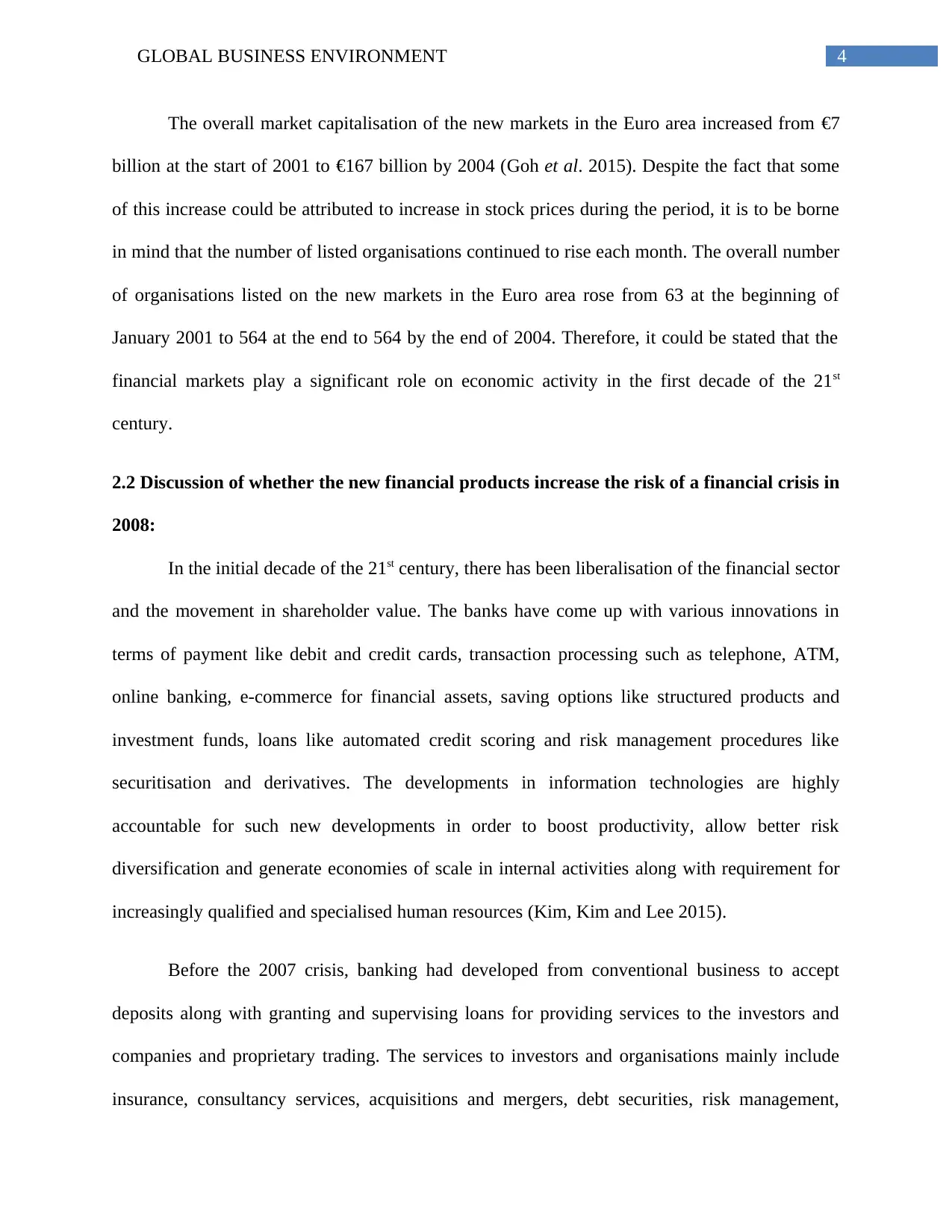
4GLOBAL BUSINESS ENVIRONMENT
The overall market capitalisation of the new markets in the Euro area increased from €7
billion at the start of 2001 to €167 billion by 2004 (Goh et al. 2015). Despite the fact that some
of this increase could be attributed to increase in stock prices during the period, it is to be borne
in mind that the number of listed organisations continued to rise each month. The overall number
of organisations listed on the new markets in the Euro area rose from 63 at the beginning of
January 2001 to 564 at the end to 564 by the end of 2004. Therefore, it could be stated that the
financial markets play a significant role on economic activity in the first decade of the 21st
century.
2.2 Discussion of whether the new financial products increase the risk of a financial crisis in
2008:
In the initial decade of the 21st century, there has been liberalisation of the financial sector
and the movement in shareholder value. The banks have come up with various innovations in
terms of payment like debit and credit cards, transaction processing such as telephone, ATM,
online banking, e-commerce for financial assets, saving options like structured products and
investment funds, loans like automated credit scoring and risk management procedures like
securitisation and derivatives. The developments in information technologies are highly
accountable for such new developments in order to boost productivity, allow better risk
diversification and generate economies of scale in internal activities along with requirement for
increasingly qualified and specialised human resources (Kim, Kim and Lee 2015).
Before the 2007 crisis, banking had developed from conventional business to accept
deposits along with granting and supervising loans for providing services to the investors and
companies and proprietary trading. The services to investors and organisations mainly include
insurance, consultancy services, acquisitions and mergers, debt securities, risk management,
The overall market capitalisation of the new markets in the Euro area increased from €7
billion at the start of 2001 to €167 billion by 2004 (Goh et al. 2015). Despite the fact that some
of this increase could be attributed to increase in stock prices during the period, it is to be borne
in mind that the number of listed organisations continued to rise each month. The overall number
of organisations listed on the new markets in the Euro area rose from 63 at the beginning of
January 2001 to 564 at the end to 564 by the end of 2004. Therefore, it could be stated that the
financial markets play a significant role on economic activity in the first decade of the 21st
century.
2.2 Discussion of whether the new financial products increase the risk of a financial crisis in
2008:
In the initial decade of the 21st century, there has been liberalisation of the financial sector
and the movement in shareholder value. The banks have come up with various innovations in
terms of payment like debit and credit cards, transaction processing such as telephone, ATM,
online banking, e-commerce for financial assets, saving options like structured products and
investment funds, loans like automated credit scoring and risk management procedures like
securitisation and derivatives. The developments in information technologies are highly
accountable for such new developments in order to boost productivity, allow better risk
diversification and generate economies of scale in internal activities along with requirement for
increasingly qualified and specialised human resources (Kim, Kim and Lee 2015).
Before the 2007 crisis, banking had developed from conventional business to accept
deposits along with granting and supervising loans for providing services to the investors and
companies and proprietary trading. The services to investors and organisations mainly include
insurance, consultancy services, acquisitions and mergers, debt securities, risk management,
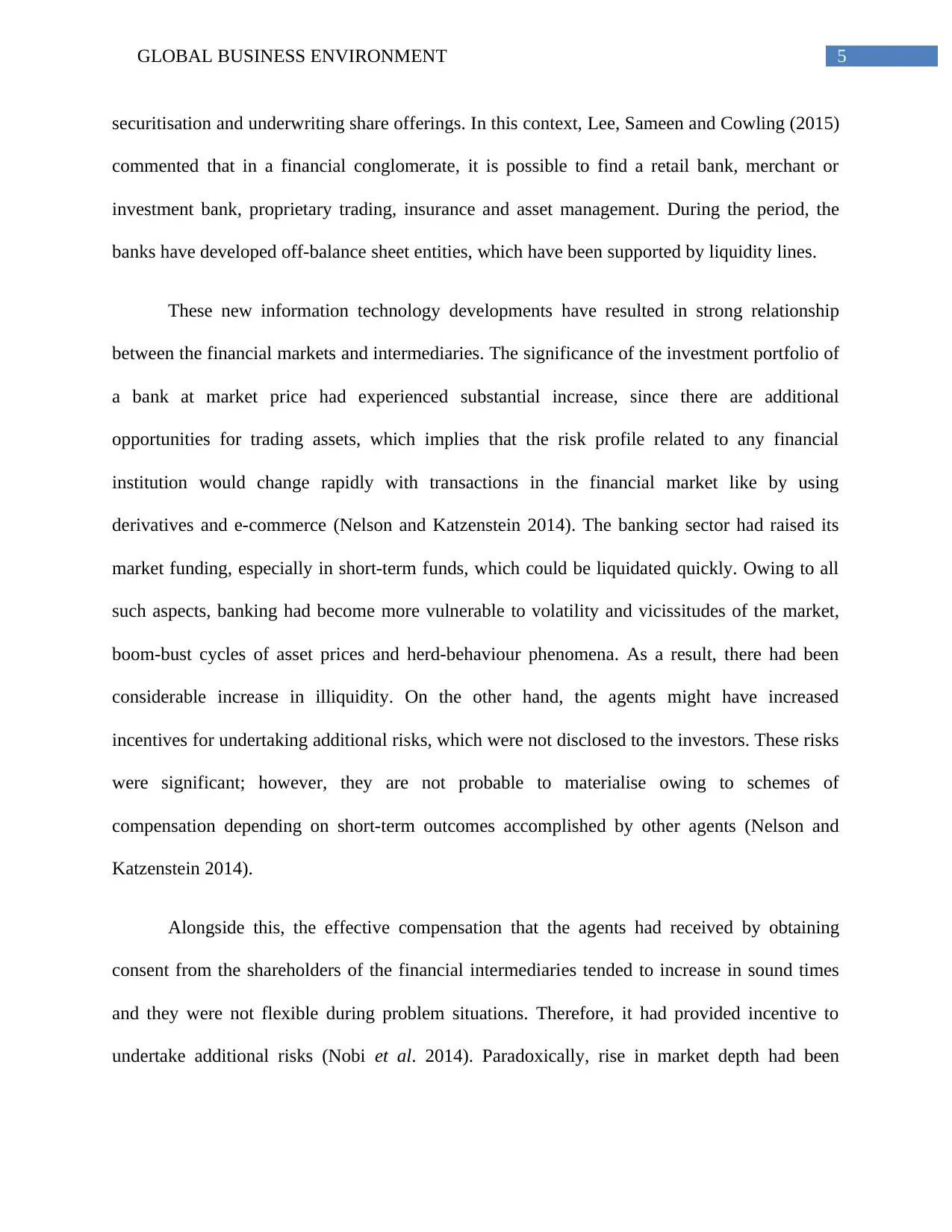
5GLOBAL BUSINESS ENVIRONMENT
securitisation and underwriting share offerings. In this context, Lee, Sameen and Cowling (2015)
commented that in a financial conglomerate, it is possible to find a retail bank, merchant or
investment bank, proprietary trading, insurance and asset management. During the period, the
banks have developed off-balance sheet entities, which have been supported by liquidity lines.
These new information technology developments have resulted in strong relationship
between the financial markets and intermediaries. The significance of the investment portfolio of
a bank at market price had experienced substantial increase, since there are additional
opportunities for trading assets, which implies that the risk profile related to any financial
institution would change rapidly with transactions in the financial market like by using
derivatives and e-commerce (Nelson and Katzenstein 2014). The banking sector had raised its
market funding, especially in short-term funds, which could be liquidated quickly. Owing to all
such aspects, banking had become more vulnerable to volatility and vicissitudes of the market,
boom-bust cycles of asset prices and herd-behaviour phenomena. As a result, there had been
considerable increase in illiquidity. On the other hand, the agents might have increased
incentives for undertaking additional risks, which were not disclosed to the investors. These risks
were significant; however, they are not probable to materialise owing to schemes of
compensation depending on short-term outcomes accomplished by other agents (Nelson and
Katzenstein 2014).
Alongside this, the effective compensation that the agents had received by obtaining
consent from the shareholders of the financial intermediaries tended to increase in sound times
and they were not flexible during problem situations. Therefore, it had provided incentive to
undertake additional risks (Nobi et al. 2014). Paradoxically, rise in market depth had been
securitisation and underwriting share offerings. In this context, Lee, Sameen and Cowling (2015)
commented that in a financial conglomerate, it is possible to find a retail bank, merchant or
investment bank, proprietary trading, insurance and asset management. During the period, the
banks have developed off-balance sheet entities, which have been supported by liquidity lines.
These new information technology developments have resulted in strong relationship
between the financial markets and intermediaries. The significance of the investment portfolio of
a bank at market price had experienced substantial increase, since there are additional
opportunities for trading assets, which implies that the risk profile related to any financial
institution would change rapidly with transactions in the financial market like by using
derivatives and e-commerce (Nelson and Katzenstein 2014). The banking sector had raised its
market funding, especially in short-term funds, which could be liquidated quickly. Owing to all
such aspects, banking had become more vulnerable to volatility and vicissitudes of the market,
boom-bust cycles of asset prices and herd-behaviour phenomena. As a result, there had been
considerable increase in illiquidity. On the other hand, the agents might have increased
incentives for undertaking additional risks, which were not disclosed to the investors. These risks
were significant; however, they are not probable to materialise owing to schemes of
compensation depending on short-term outcomes accomplished by other agents (Nelson and
Katzenstein 2014).
Alongside this, the effective compensation that the agents had received by obtaining
consent from the shareholders of the financial intermediaries tended to increase in sound times
and they were not flexible during problem situations. Therefore, it had provided incentive to
undertake additional risks (Nobi et al. 2014). Paradoxically, rise in market depth had been
⊘ This is a preview!⊘
Do you want full access?
Subscribe today to unlock all pages.

Trusted by 1+ million students worldwide

6GLOBAL BUSINESS ENVIRONMENT
accompanied by a considerable increase in systematic risk. As a result, the new financial
products introduced by the banking sector had contributed to the 2007 global financial crisis.
3. Conclusion:
Based on the above analysis, it is apparent that the financial markets had significant
impact on economic activity in the first decade of the 21st century. One of the most noteworthy
reasons is that the share markets during that period were not developed properly, which was a
major drawback for any economy. However, the situation had improved within shorter
timeframe, which was evident from the increase in market capitalisation of the Euro area and
number of organisations listed in the stock markets. On the other hand, it has been found that the
banking sector had introduced certain new products like debit and credit cards, ATMs and others
in the initial decade of the 21st century. With the initiation of such products, close association
developed between the financial intermediaries and financial markets. The agents undertook
additional risks, which were found to be complex in crisis situations. This increased the overall
systematic risk and it eventually contributed to the global financial crisis.
4. Recommendations:
In order to avoid the possibility of any future banking crisis, it is crucial to consider
dynamic view of capital. If there is fall in market value of equity to assets, it would result in
decline in bank profits and thus, measures should be taken for countering such situation
(Reinhart and Rogoff 2014). Secondly, it is necessary for the regulators to attend to franchise
value by minimising the needless burden to banks and other financial institutions. Regulatory
costs are significantly high for small banks, as there are certain economies of scale in functions
of compliance. Moreover, the incomplete regulation against banks in favour of shadow banks
accompanied by a considerable increase in systematic risk. As a result, the new financial
products introduced by the banking sector had contributed to the 2007 global financial crisis.
3. Conclusion:
Based on the above analysis, it is apparent that the financial markets had significant
impact on economic activity in the first decade of the 21st century. One of the most noteworthy
reasons is that the share markets during that period were not developed properly, which was a
major drawback for any economy. However, the situation had improved within shorter
timeframe, which was evident from the increase in market capitalisation of the Euro area and
number of organisations listed in the stock markets. On the other hand, it has been found that the
banking sector had introduced certain new products like debit and credit cards, ATMs and others
in the initial decade of the 21st century. With the initiation of such products, close association
developed between the financial intermediaries and financial markets. The agents undertook
additional risks, which were found to be complex in crisis situations. This increased the overall
systematic risk and it eventually contributed to the global financial crisis.
4. Recommendations:
In order to avoid the possibility of any future banking crisis, it is crucial to consider
dynamic view of capital. If there is fall in market value of equity to assets, it would result in
decline in bank profits and thus, measures should be taken for countering such situation
(Reinhart and Rogoff 2014). Secondly, it is necessary for the regulators to attend to franchise
value by minimising the needless burden to banks and other financial institutions. Regulatory
costs are significantly high for small banks, as there are certain economies of scale in functions
of compliance. Moreover, the incomplete regulation against banks in favour of shadow banks
Paraphrase This Document
Need a fresh take? Get an instant paraphrase of this document with our AI Paraphraser
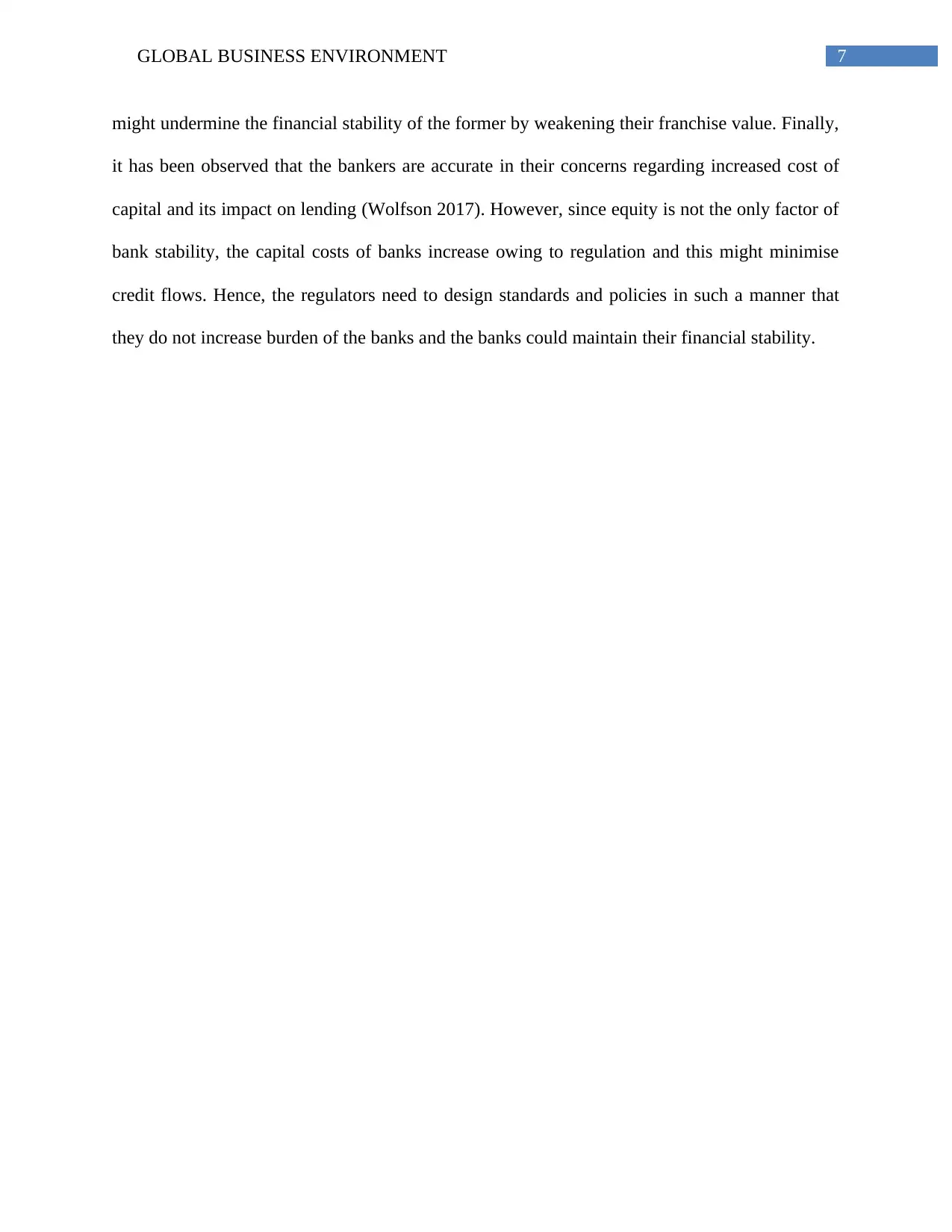
7GLOBAL BUSINESS ENVIRONMENT
might undermine the financial stability of the former by weakening their franchise value. Finally,
it has been observed that the bankers are accurate in their concerns regarding increased cost of
capital and its impact on lending (Wolfson 2017). However, since equity is not the only factor of
bank stability, the capital costs of banks increase owing to regulation and this might minimise
credit flows. Hence, the regulators need to design standards and policies in such a manner that
they do not increase burden of the banks and the banks could maintain their financial stability.
might undermine the financial stability of the former by weakening their franchise value. Finally,
it has been observed that the bankers are accurate in their concerns regarding increased cost of
capital and its impact on lending (Wolfson 2017). However, since equity is not the only factor of
bank stability, the capital costs of banks increase owing to regulation and this might minimise
credit flows. Hence, the regulators need to design standards and policies in such a manner that
they do not increase burden of the banks and the banks could maintain their financial stability.
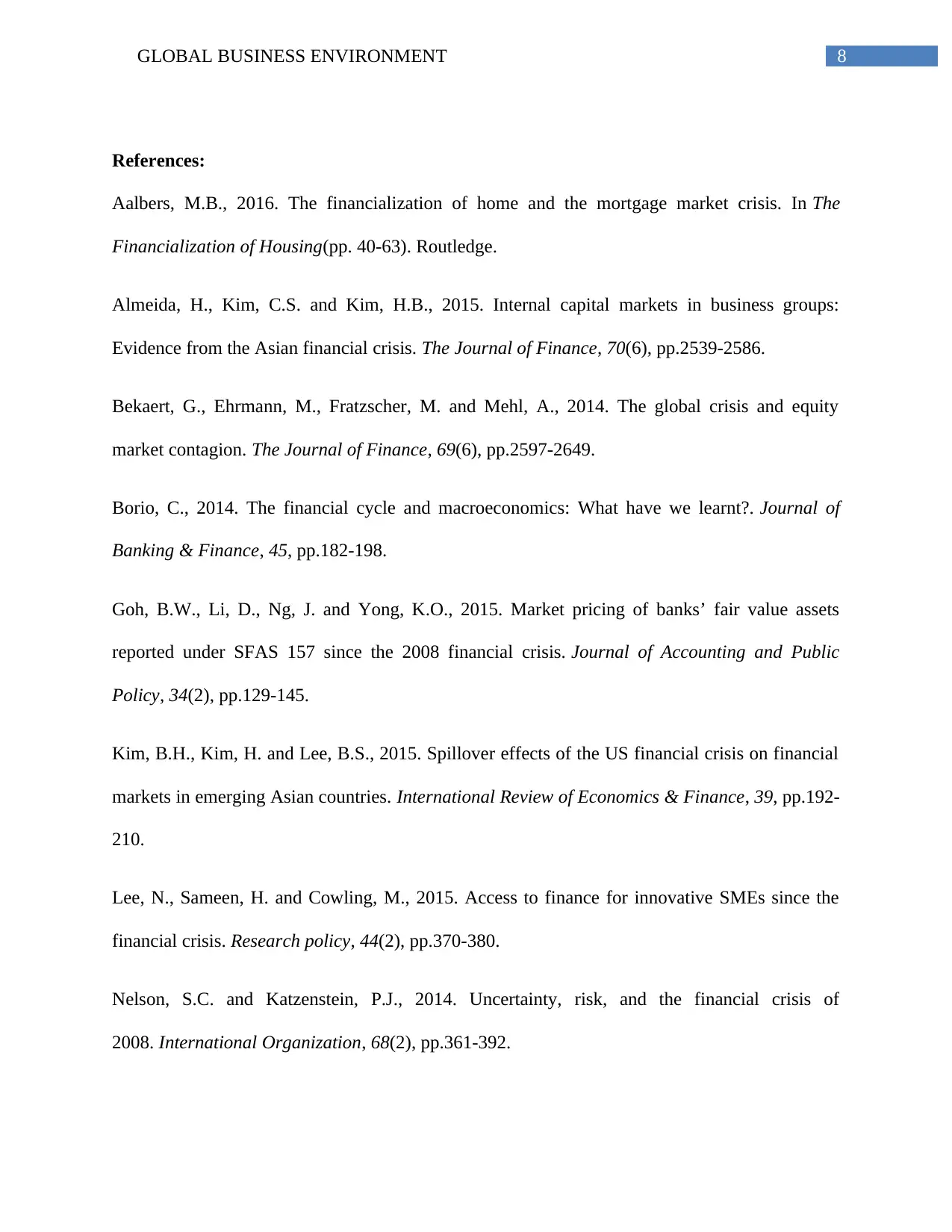
8GLOBAL BUSINESS ENVIRONMENT
References:
Aalbers, M.B., 2016. The financialization of home and the mortgage market crisis. In The
Financialization of Housing(pp. 40-63). Routledge.
Almeida, H., Kim, C.S. and Kim, H.B., 2015. Internal capital markets in business groups:
Evidence from the Asian financial crisis. The Journal of Finance, 70(6), pp.2539-2586.
Bekaert, G., Ehrmann, M., Fratzscher, M. and Mehl, A., 2014. The global crisis and equity
market contagion. The Journal of Finance, 69(6), pp.2597-2649.
Borio, C., 2014. The financial cycle and macroeconomics: What have we learnt?. Journal of
Banking & Finance, 45, pp.182-198.
Goh, B.W., Li, D., Ng, J. and Yong, K.O., 2015. Market pricing of banks’ fair value assets
reported under SFAS 157 since the 2008 financial crisis. Journal of Accounting and Public
Policy, 34(2), pp.129-145.
Kim, B.H., Kim, H. and Lee, B.S., 2015. Spillover effects of the US financial crisis on financial
markets in emerging Asian countries. International Review of Economics & Finance, 39, pp.192-
210.
Lee, N., Sameen, H. and Cowling, M., 2015. Access to finance for innovative SMEs since the
financial crisis. Research policy, 44(2), pp.370-380.
Nelson, S.C. and Katzenstein, P.J., 2014. Uncertainty, risk, and the financial crisis of
2008. International Organization, 68(2), pp.361-392.
References:
Aalbers, M.B., 2016. The financialization of home and the mortgage market crisis. In The
Financialization of Housing(pp. 40-63). Routledge.
Almeida, H., Kim, C.S. and Kim, H.B., 2015. Internal capital markets in business groups:
Evidence from the Asian financial crisis. The Journal of Finance, 70(6), pp.2539-2586.
Bekaert, G., Ehrmann, M., Fratzscher, M. and Mehl, A., 2014. The global crisis and equity
market contagion. The Journal of Finance, 69(6), pp.2597-2649.
Borio, C., 2014. The financial cycle and macroeconomics: What have we learnt?. Journal of
Banking & Finance, 45, pp.182-198.
Goh, B.W., Li, D., Ng, J. and Yong, K.O., 2015. Market pricing of banks’ fair value assets
reported under SFAS 157 since the 2008 financial crisis. Journal of Accounting and Public
Policy, 34(2), pp.129-145.
Kim, B.H., Kim, H. and Lee, B.S., 2015. Spillover effects of the US financial crisis on financial
markets in emerging Asian countries. International Review of Economics & Finance, 39, pp.192-
210.
Lee, N., Sameen, H. and Cowling, M., 2015. Access to finance for innovative SMEs since the
financial crisis. Research policy, 44(2), pp.370-380.
Nelson, S.C. and Katzenstein, P.J., 2014. Uncertainty, risk, and the financial crisis of
2008. International Organization, 68(2), pp.361-392.
⊘ This is a preview!⊘
Do you want full access?
Subscribe today to unlock all pages.

Trusted by 1+ million students worldwide
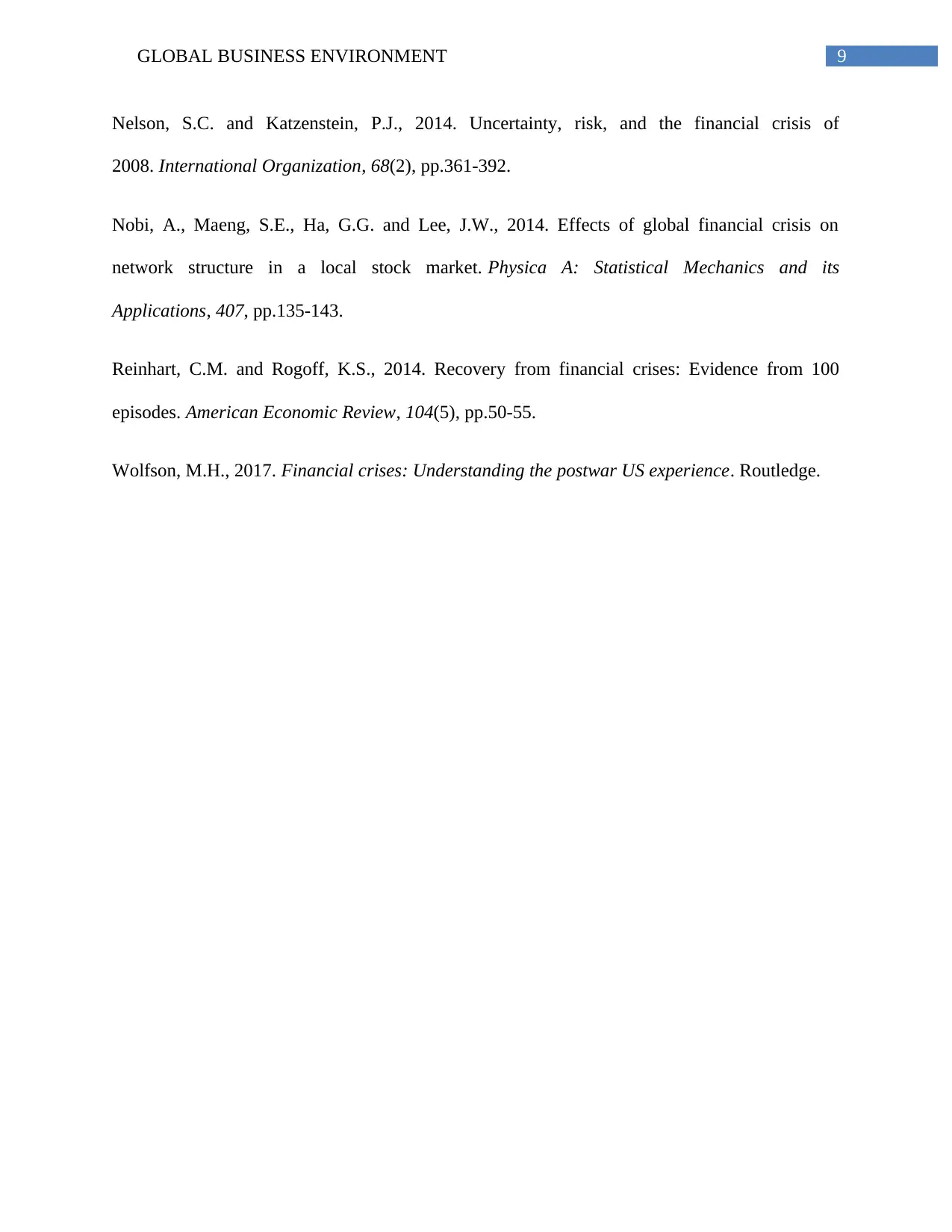
9GLOBAL BUSINESS ENVIRONMENT
Nelson, S.C. and Katzenstein, P.J., 2014. Uncertainty, risk, and the financial crisis of
2008. International Organization, 68(2), pp.361-392.
Nobi, A., Maeng, S.E., Ha, G.G. and Lee, J.W., 2014. Effects of global financial crisis on
network structure in a local stock market. Physica A: Statistical Mechanics and its
Applications, 407, pp.135-143.
Reinhart, C.M. and Rogoff, K.S., 2014. Recovery from financial crises: Evidence from 100
episodes. American Economic Review, 104(5), pp.50-55.
Wolfson, M.H., 2017. Financial crises: Understanding the postwar US experience. Routledge.
Nelson, S.C. and Katzenstein, P.J., 2014. Uncertainty, risk, and the financial crisis of
2008. International Organization, 68(2), pp.361-392.
Nobi, A., Maeng, S.E., Ha, G.G. and Lee, J.W., 2014. Effects of global financial crisis on
network structure in a local stock market. Physica A: Statistical Mechanics and its
Applications, 407, pp.135-143.
Reinhart, C.M. and Rogoff, K.S., 2014. Recovery from financial crises: Evidence from 100
episodes. American Economic Review, 104(5), pp.50-55.
Wolfson, M.H., 2017. Financial crises: Understanding the postwar US experience. Routledge.
1 out of 10
Related Documents
Your All-in-One AI-Powered Toolkit for Academic Success.
+13062052269
info@desklib.com
Available 24*7 on WhatsApp / Email
![[object Object]](/_next/static/media/star-bottom.7253800d.svg)
Unlock your academic potential
Copyright © 2020–2025 A2Z Services. All Rights Reserved. Developed and managed by ZUCOL.





